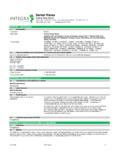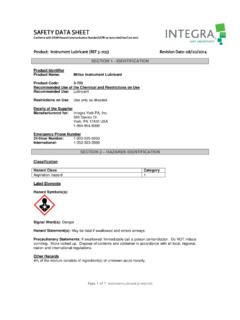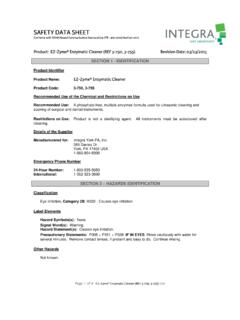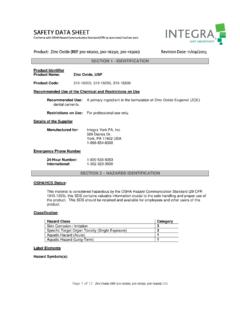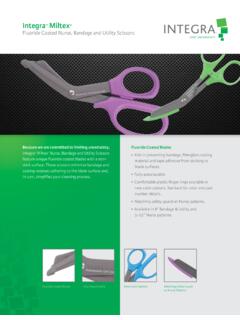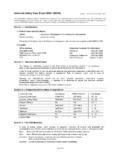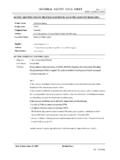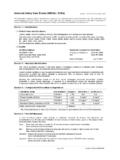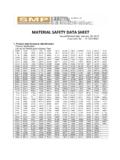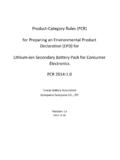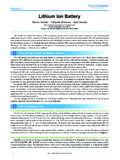Transcription of LITHIUM-ION BATTERY MATERIAL SAFETY DATA …
1 MATERIAL SAFETY data Sheet LITHIUM-ION BatteryEffective Date: Jan 1, 2010 LITHIUM-ION BATTERY MATERIAL SAFETY data SHEET (MSDS) SECTION I - MANUFACTURER INFORMATION Manufactured for: Miltex, Inc. 589 Davies Drive York, PA 17402 II - HAZARDOUS IN GREDIE NTS MATERI AL OR INGREDIENT PEL (OSHA) TLV (ACGIH) %/wt. Acetylene Black (CAS# 1333- 86-4) mg/m3 TWA (as carbon black) mg/m3 TWA (as carbon black) 0-2 Biphenyl (CAS# 92-52-4) 1 mg/m3 TWA ppm TWA ppm TWA 0-15 Diethyl Carbonate (CAS# 105- 58-8) None established None established0-15 Dimethyl Carbonate (CAS# 616- 38-6) None established None established0-15 Ethyl Methyl C ar bonate (CAS# 623-53-0) None established None established0-15 Ethylene Carbonate (CAS# 96-49-1) None established None established0-15 Graphite (CAS# 7782-42-5) 5 mg/m3 TWA (r espirable fraction) 15 mg/m3 TWA (t otal dust) 2 mg/m3 TWA (r espirable fraction)7-22 lithium Cobalt Oxide (CAS# 12190-79-3) mg/m3 TWA (as Co) mg/m3 TWA (as Co) 15-30 lithium Hexafluorophosphate (CAS# 21324-40-3) None establishedNone established 0-5 lithium Tetrafluoroborate (CAS# 14283-07-9)
2 None establishedNone established0-5n-Methyl P yrrolidinone (CAS# 872-50-4) None establishedNone established0-1 Oxalic Acid (CAS# 144-62-7) 1 mg/m3 TWA 1 mg/m3 TWA 2 mg/m3 STEL 0-1 Propylene Carbonate (CAS# 108-32-7) None establishedNone established0-15 IMPORTANT NOTE: The BATTERY should not be opened or incinerated. Exposure to the ingredients contained within or their combustion products could be harmful. SECTION III - FIRE AND EXPLOSION HAZARD data If fire or explosion occurs when batteries are on charge, shut off power to charger. In case of fire where lithium ion batteries are present, flood the area w ith water. If any batteries are burning, wat er may not extinguish them, but w ill cool the adjacent batteries and control the spread of fire. CO2, dry chemical, and foam extinguishers are preferred for small fires, but also may not e xtinguish burning lithium ion batteries. Burning batteries will burn themselves out.
3 Virtually all fires involving lithium ion batteries can be controlled with water. When water is used, however, h ydrogen gas may be evolved which can form an explosive mixture with air. LITH- X (powdered graphite) or copper powder fire extinguishers, sand, dry g round dolomite or soda ash may also be used. These mat er ials act as smothering agents. Fire fighters should wear self-contained breathing apparat us. Burning lithium ion batteries can produce toxic fumes including HF, oxides of c ar bon, aluminum, lithium , copper, and cobalt. Volatile phosphorus pentafluoride may form at a temperature above 230 IV - HEALTH HAZARD data Under normal conditions of use, the BATTERY is hermetically sealed. Ingestio n: Swallowing a bat tery can be harmful. Contents of an open BATTERY can cause serious chemical burns of mouth, esophagus, and gastrointestinal tract. If BATTERY or open BATTERY is ingested, do not induce vomiting or give food or drink.
4 Seek medical attention immediately. CALL NATIONAL BATTERY INGESTION HOTLINE for advice and follow-up (202-625-3333) collect, day o r night. Inhalation: Contents of an open BATTERY can cause respiratory i rritation. Inhalation of vapors may cause irritation of the upper respiratory tract and lungs. Provide fresh air and seek medical attention. Page 1 of 3 MATERIAL SAFETY data Sheet LITHIUM-ION BatteryEffective Date: Jan 1, 2010 SECTION IV - HEALTH HAZARD data - (Continued) Skin Absorp tion: N-methyl pyrrolidinone, ethylene carbonate, ethyl methyl carbonate, dimethyl carbonate, and biphenyl may be absor bed through the skin causin g localized inflammation. Skin Contact: Contents of an open BATTERY can cause skin irritation and/or chemical burns. Remove contaminated clothing and wash skin with soap and wat er. I f a chemical burn occurs or if irritat ion persists, seek medical attention. Eye Contact: Contents of an open BATTERY can cause severe irritation and chemical burns.
5 Immediately flush eyes thoroughly with wat er for at least 15 minutes, lifting upper and lower lids, until no evidence of the chemical remains. Seek medical : Acetylene black and cobalt compounds are listed as possible carcinogens by t he International Agency for Research on Cancer (IARC). SECTION V - PRECAUTIONS FOR SAFE HANDLING AND USE Storage: The lithium ion BATTERY should be between 25% and 75% of full charge when stored for a long period of time. Store in a cool, dry, well ventilated area. Elevated temperatures can result in loss of BATTERY p erformance, leakage, or rust. Do not expose the BATTERY to open Containment: Containment of this BATTERY in a manner that obstructs or defeats the SAFETY vent or electrical disconnect mechanisms designed into this BATTERY can result in fire and/or explosion and cause personal injury and device damage. T his BATTERY is not designed to be potted, enclosed in hermetic overpackaging, or sealed by any means that prevents free operation of t he designed saf et y : Do not expose the BATTERY to excessive physical shock or v ibration.
6 S hort c irc uit ing should be avoided, however, accidental short circuiting for a few s econds will not seriously affect the BATTERY . Prolonged short circuits will cause the BATTERY to rapidly lose energ y, could generate enough heat t o burn skin, and may cause the safet y release vents of t he enclosed cells t o open. S ources of short circuits include jumbled batteries in bulk c ontainers, coins, met al jewelry, met al cover ed tables, or met al belts used for assembl y of b atteries in devic es. T o minimize risk of short circuiting, t he prot ective cas e sup plied with the bat tery should be used to cover the terminals when transporting or storing the BATTERY . Do not disassemble or deform the BATTERY . Should an individual cell within a BATTERY become ruptured, do not allow contact with soldering or welding to the BATTERY is required, use of tabbed batteries is recommended. Soldering directly to the cell can damage the BATTERY s af et y s eal, c ause internal damage or short circuit the cell.
7 Charging: This BATTERY is made to be charged many times. Use an approved BATTERY charger. Never use a modified or damaged BATTERY charger. Do not charge for over 180 minutes or repeat charging without inter mittent discharging. A backup charge termination based on time is recommended to prevent overcharging. The charging temperature should be between 0 C and 50 C (32 F and 120 F). The BATTERY p ack will normally warm during Voltages and Currents: Charging voltages are prevented f rom exceeding the specified limits by an internal BATTERY p rotection circuit. Never use a batter y which shows signs of a damaged protection circuit or brok en case. (Such damage to the protection circuit may be indicated b y v oltages at t he BATTERY t erminals outside of their specified ranges.) Adhere to all specified charging and discharging voltages and currents. Do not use BATTERY if its voltage drops below the specified minimum ng: If the label or package warnings are not visible, it is important to provide a package and/ or device label stating: WARNING: CHARGE ONLY WITH SPECIFIED CHARGERS A CCORDING TO DEVICE MANUFACTURER S INSTRUCTIONS.
8 DO NOT OPEN BATTERY , DISPOSE OF IN FIRE, OR SHORT CIRCUIT - MAY IGNITE, EXPLODE, LEAK, OR GET HOT CAUSING PERSONAL : Dispose in accordance with all applicable federal, st at e, and local 2 of 3 MATERIAL SAFETY data Sheet LITHIUM-ION BatteryEffective Date: Jan 1, 2010 SECTION VI - SPECIAL PROTECTION INFORMATION Ventilation Requirements : Not necessary u nder normal conditions. Respirator y Protection: Not necessary u nder normal conditions. Eye Protection: Not necessary u nder normal conditions. Wear SAFETY glasses with side shields if handling an open or leaking BATTERY . Gloves: Not necessary u nder normal conditions. Use neoprene or natural rubber gloves if handling an open or leaking BATTERY S torage: BATTERY should not be opened. Should a cell become disassembled, t he electrode should be stored in a fireproof cabinet, away f rom VII REGULATORY INFORMATION The transportation of LITHIUM-ION (and any other re chargeable lithium chemistries) packs with up to 8 grams of equivalent lit hium c ontent, as described in this document, is not regulated by t he Department of Transportation or the major international regulatory bodies.
9 Equivalent lit hium content f or lithium ion and lithium polymer cells and batteries in grams on a per cell basis is calculated as times the rated capacit y in ampere-hours. The equivalent lithium content for a BATTERY o r batter y p ack is the rated capacity in ampere-hours for a single cell multiplied by and then multiplied by the number of cells in the BATTERY . Transporta tion: Land Transport (ADR/RID) The product fulfills the requirements of S pecial Provis ion 188 of A DR/RI D and is therefor e, keeping within the prescribed quantit y limits, excepted from the application of the Dangerous Goods Transport (IMDG) - The product fulfills the requirements of Special Provision 188 of IMDG-Code and is therefor e, keeping within the prescribed quantit y limits, excepted from the application of the Dangerous Goods Transport (IATA) - The product fulfills the requirements of Special Provision A45 of IATA-DGR and is therefore, keeping within the prescribed quant it y limits, excepted from the application of the Dangerous Goods regulations.
10 SARA/TITLE III As an article, thi s BATTERY and its contents are not subject to the requirements of the Emergency Planning and Co mmunity Right-To-K now Ac 3 of 3 This MATERIAL SAFETY data Sheet is applicable for th e following product numbers: Model 15057 Li-Ion BatteryThe information contained in this document is provided for information only. The batteries described in this document are articles pursuant to 29 CFR and, as such, are not subject to the OSHA Hazard Communication Standard requirement for preparation of a MATERIAL SAFETY data sheet. The information and recommendations in this document are made in good faith and are believed to be accurate as of the date of preparation. However, MILTEX, INC., MAKES NOWARRANTY, EITHER EXPRESS OR IMPLIED, WITH RESPECT T O T HIS INFORMATION AND DISCLAIMS ALL LIABILITY FROM RELIANCE ON IT.
